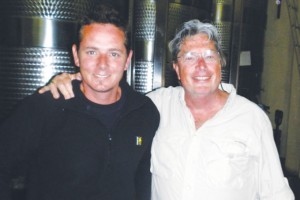Tasting South Africa

Gottried Mocke, South Africa’s 2013 Winemaker of the Year from Chamonix Winery, at the winery with Joaquin Carbonell, owner of Uncorked by the Sea Wine Shop & Gallery. Courtesy photo
We believe that the more we know about wine and its origins, the better service we can provide our customers at Uncorked by the Sea Wine Shop & Gallery in Southport. That, and our love of travel, lead to our goal of visiting at least one of the world’s major wine regions each year. South African wines are not very well known in the United States but are very well received in other parts of the world, so we decided to find out for ourselves. While we made some great discoveries, we found that only a small percentage of South African wine production makes it to the United States. Now that we have experienced the country and its wines, we are always on the lookout for South African wines to offer our customers.
A Little History
The wines of South Africa are as diverse and exciting to explore as the country itself. Although South Africa is regarded as a New World wine producer, its wine history dates to the 1600s. Jan van Riebeeck came to the Cape in 1652 to establish a settlement on behalf of the Dutch East India Company to provide fresh food to the company’s merchant fleet on their voyages to India and surrounding areas. The establishment of this trading station led to a flourishing wine industry and later to the birth of a nation.
Vineyards were planted more extensively a generation later, when the French Huguenots began arriving in 1688 fleeing religious persecution. There were many setbacks in the beginning, chiefly because of the farmers’ ignorance of viticulture.
Things improved when van Riebeeck was succeeded as governor in 1679 by Simon van der Stel, who was not only enthusiastic but very knowledgeable about viticulture and winemaking. He planted a vineyard on his farm, “Constantia.”
Later, Constantia was acquired by the Cloete family and their wines became world-famous. By the 18th century they were being served in Europe to the nobility, to Napoleon when in exile on the island of St Helena and written about by Jane Austen.
Constantia remains a thriving winery and its wine is mentioned when the world’s finest examples are discussed to this day. We visited the winery last winter and its original buildings are still in use and are a prime example of the Dutch Cape style of architecture.
In the late 19th century and early 20th century, German and Italian immigrants began settling at the Cape, introducing their winegrowing and winemaking traditions. South Africa’s vineyards are mostly found in the Western Cape near the coast. Despite its African geography, the Western Cape, situated at the southernmost tip of Africa, enjoys a Mediterranean climate with cool, wet winters and warm, dry summers ideally suited to winegrowing. Very importantly, sea breezes from the Atlantic and Indian oceans cool the vineyards during the summer afternoons, slowing the ripening process and intensifying flavors.
There are more than 450 wineries spread through the country’s 15 wine regions producing some exceptional wines. The most widely grown whites are Chenin Blanc, Colombard, Chardonnay and Sauvignon Blanc. The most popular reds are Cabernet Sauvignon, Shiraz, Merlot and Pinotage. A local cross between Pinot Noir and Cinsault, created in 1925, Pinotage is unique to South Africa. While not one of our favorite varietals, it can produce complex and fruity wines with age but is also often very drinkable when young.
Franschhoek Valley
We visited wineries in the Constantia, Franschhoek Valley, Paarl and Stellenbosch wine regions. Without a doubt, our favorite region was the Franschhoek Valley located north of Cape Town. Sadly, we found that many of our favorites are not exported to the United States as only 6 percent of all South African wine production makes it to the U.S. One of our favorite wineries was Chamonix. We had a cellar tasting with winemaker Gottfried Mocke who was named South Africa’s Winemaker of the Year for 2013. We particularly enjoyed a limited release called Marco Polo, a Bordeaux-inspired blend of 40 percent Cabernet Sauvignon, 30 percent Merlot, and 30 percent Cabernet Franc, which was exceptional.
The town of Franschhoek (“French Corner” in Dutch) is small and friendly—a lot like Southport. The town is filled with good restaurants, art galleries and wine shops. It also is home to La Residence, just named the world’s number one hotel by Conde Nast Traveler’s Readers Choice Awards. Visit the hotel website at www.laresidence.co.za to see why. We stayed in the Chambre Bleu suite, which was quite luxurious. However, the staff and level of service is really what makes it special.
Afterthoughts
We have so many great memories of our South African visit. Cape Town is beautiful with the majestic Table Rock overlooking the city. The Kruger Park is all we thought it would be and more as we sighted all of the “Big Five.” Robben Island where Nelson Mandela was imprisoned gave us a new appreciation of the undaunted spirit of this great man. Standing at the Cape of Good Hope, which marks the point where a ship begins to travel more eastward than southward, had us dreaming of those adventurous explorers centuries ago.
Uncorked will host wine tastings on alternate Thursdays through March from 5 p.m. to 7 p.m. benefiting Matthew’s Ministry.











Leave a Reply